Effects of planting patterns plastic film mulching on soil temperature, moisture, functional bacteria and yield of winter wheat in the Loess Plateau of China
2023-05-08ZHAOXiaodongQlNXiaoruiLlTingliangCAOHanbingXlEYinghe
ZHAO Xiao-dong, QlN Xiao-rui, Ll Ting-liang, CAO Han-bing, XlE Ying-he
1 College of Biological Sciences and Technology, Taiyuan Normal University, Yuci 030619, P.R.China
2 College of Resources and Environment/State Key Laboratory of Integrative Sustainable Dryland Agriculture (in preparation), Shanxi Agricultural University, Taiyuan 030031, P.R.China
Abstract The yield of winter wheat is hindered by drought and low temperature in the Loess Plateau of China.Two common mulching methods to conserve soil moisture, ridge furrows with plastic film mulching (RP) and flat soil surfaces with plastic film mulching (FP) are helpful for wheat production.Our previous study indicated that FP could improve wheat yield more effectively than RP, but the reason remains unclear.The effect of mulching method on functional bacteria also needs to be further studied.In this study, winter wheat was employed to evaluate the impacts of mulching method on soil temperature, moisture content, microorganisms and grain yield.The results showed that FP had a warming effect when the soil temperature was low and a cooling effect when the temperature was too high.However, the ability to regulate soil temperature in the RP method was unstable and varied with year.The lowest negative accumulated soil temperature was found in the FP treatment, which was 20–89 and 43–99% lower than that of the RP and flat sowing with non-film mulching control (NP) treatments, respectively.Deep soil moisture was better transferred to topsoil for wheat growth in the FP and RP treatments than the NP treatment, which made the topsoil moisture in the two treatments (especially FP) more sufficient than that in the NP treatment during the early growing stage of wheat.However, due to the limited water resources in the study area, there was almost no difference between treatments in topsoil water storage during the later stage.The wheat yield in the FP treatment was significantly higher, by 12–16 and 23–56%, respectively, than in the RP and NP treatments.Significant positive correlations were observed among the negative accumulated soil temperature, spike number and wheat yield.The Chao1 and Shannon indices in the RP treatment were 17 and 3.9% higher than those in the NP treatment, respectively.However, according to network relationship analysis, the interspecific relationships of bacteria were weakened in the RP treatment.Phosphorus solubilizing, ammonification and nitrification bacteria were more active in the RP than in the FP treatment, and microbeswith nitrate reduction ability and plant pathogens were inhibited in the RP treatment, which improved nutrient availability and habitat for wheat.
Keywords: winter wheat, soil temperature, moisture, functional bacteria, grain yield
1.lntroduction
Wheat (TriticumaestivumL.) is the main grain crop in the world, with more than 125 countries planting wheat in an area of more than 220 million hectares in recent years; thus, wheat plays an important role in ensuring food security (Liu Het al.2021).As the largest wheat producer and consumer country, China accounts for approximately 18 and 20% of worldwide production and consumption, respectively (Fanet al.2020; Liu Het al.2021).In China, grain demand has increased rapidly owing to the evergrowing human population, so it is imperative to improve wheat production (Wanget al.2020).The Loess Plateau of China is the major producing area for winter wheat (Wanget al.2018).In this area, however, the wheat yield is limited by moisture and temperature stress.
Irrigation can provide water for wheat growth, which is conducive to winter wheat yield (Zenget al.2021).Compared with conventional irrigation treatment, microsprinkling irrigation enhanced grain yield, protein yield and grain protein concentration of winter wheat 11–17, 19–25, and 5–8%, respectively (Li J Pet al.2021).Alternate furrow irrigation, a water-saving irrigation strategy, improved nitrogen use and uptake efficiency, reduced nitrate leaching loss in the upper soil layer, and increased the yield of winter wheat (Jiaet al.2021).Unfortunately, due to the poor irrigation conditions in some areas of the Loess Plateau, precipitation represents the only water source for wheat growth.
Film mulching can increase wheat yield by regulating soil temperature and moisture, and is a common agricultural measure in rain-fed farmland areas of northern China (Yanet al.2018; Zhanget al.2018; Li Y Wet al.2021).Plastic film mulching with ridge furrows and flat soil surfaces are two common methods used in crop production in arid and semiarid areas of China (Liuet al.2016; Wuet al.2017; Li Cet al.2021; Zhanget al.2021).In our previous study, wheat yield when the flat soil surface plastic film mulching method was used was 14% (P<0.05) higher than that when the ridge furrow method was used (Liet al.2019).Whether their disparity in wheat yield between the above two mulching methods was related to soil temperature and moisture remained unclear.
Soil microorganisms are important components of crop nutrient acquisition and can interfere with root exudates, excrete enzymes, and drive the nitrogen and phosphorus cycles (Li Y Zet al.2021; Ranet al.2021; Sunet al.2021).Plastic film mulching may change the microbial community structure and soil metabolite spectrum and reduce the complexity and stability of microbial interactions (Liu J Let al.2021; Luoet al.2022; Wuet al.2022), however it does provide a favourable environment for microbial survival under low-temperature stress.Our previous research indicated that the ridge furrow with plastic film mulching method improved the content of crop available nitrogen (Liet al.2019), and soil nitrogen cycling microorganisms might play an important role in this improvement.Therefore, the effect of film mulching planting method on nitrogen cycling microbes needed to be further studied.
In this research, the effects of the plastic film mulching with ridge furrows and flat soil surfaces methods on winter wheat were compared in the Loess Plateau of China.Our objective was to explore the spatiotemporal variation characteristics of soil temperature and moisture under the above two planting methods to determine the relationships among soil temperature, moisture and wheat yield.We aimed to study the influence of film mulching method on the composition, structure and interaction of functional microorganisms, especially nitrogen cycling microbes, under low-temperature stress.
2.Materials and methods
2.1.Site description
The experiment was carried out from 2014–2016 in Hongtong County (coordinate: 36°23´6.07´´N, 111°31´52.0´´E; altitude 648 m a.s.l), Shanxi Province, China, which is located on the semiarid area of Loess Plateau.The region has an annual average temperature of 12.6°C, a frost-free period of 180–210 d, an annual precipitation of 328–699 mm, and an annual mean sunshine duration of 2 419 h.Based on the Chinese Soil Taxonomic Classification, the soil is a calcareous cinnamon silt loam.The soil pH at the study site was 7.6, and the organic matter, total nitrogen, nitrate nitrogen, and available phosphorus, and potassium concentrations were 14 400, 750, 12.3, 12.6 and 236 mg kg–1, respectively.
2.2.Experimental design
Three plastic film mulching methods were compared in this study: (1) flat soil surface with plastic film mulching (FP; Fig.1-A), (2) ridge furrow with plastic film mulching (RP; Fig.1-B) and (3) flat soil surface with non-film mulching control (NP; Fig.1-C).Urea (N 46%), calcium superphosphate (P2O511%) and potassium chloride (K2O 60%) were used as N, P and K fertilizers, respectively.Monitored fertilization was employed to ensure that the soil nutrient content in each treatment was consistent (Liet al.2019).The local winter wheat variety Chang 8744 was selected for this research.Seed for the NP and RP treatments were sown in the ditch while the seed in FP treatment was hole-sown.The sowing rate in all treatments was 150 kg ha–1.The sowing dates were October 1, 2014, and October 3, 2015, and the harvest times were June 7, 2015 and June 5, 2016.Film mulching was maintained throughout the growth period of winter wheat without irrigation.

Fig.1 Schematic diagrams and images of flat soil surface with plastic film mulching (A), ridge furrow with plastic film mulching (B) and flat sowing without film mulching control (C).
2.3.Sampling and measurement
Soil temperature and moistureDuring the whole wheat growth period, the soil temperature at the 5, 10, 20, and 40 cm depths was recorded hourly using an automatic temperature data collector (HOBO UTBI-001).The active accumulated soil temperature was the sum of the daily average soil temperatures above 10°C, as was the negative accumulated soil temperature (below 0°C).
Soil samples (0–20 and 20–40 cm) were collected at the returning green stage, jointing stage, flowering stage and harvest stage of wheat to measure the soil water content by the oven-drying method (Zhanget al.2018).Soil water storage (SWS) was calculated as follows (Liet al.2019):
where W is the soil water content (%), T is the soil layer thickness (cm), and D is the soil bulk density (g cm–3).
Wheat yield and componentsThe wheat yield was measured in a 60-m2plot at the centre of each treatment.Three wheat rows (1 m length) in each treatment were randomly selected for measurement of yield components (spike number, kernel number per spike and kernel weight) during the harvest time.
Biological analysisTo determine the effect of mulching treatment on microbial community in the overwintering period of winter wheat, soil samples in the RP and NP treatments of 2020–2021 were collected for highthroughput sequencing.The bacterial sequencing method used was similar to that used in our previous study (Zhaoet al.2021).Briefly, total genomic DNA was extracted according to the method of the DNA isolation kit instructions.The diluted DNA (1 ng μL–1) was amplified as follows: 1 min at 98°C (initial denaturation); 30 cycles consisting of denaturation at 98°C for 10 s, renaturation at 50°C for 30 s, and extension at 72°C for 30 s; and a final extension at 72°C for 5 min.The amplification primers 338F (5´-ACTCCTACGGGAGGCAGCAG-3´) and 806R (5´-GGACTACHVGGGTWTCTAAT-3´) were employed to amplify the V3–V4 regions of the 16S rRNA gene (Nanet al.2016).The samples were mixed based on the concentration of the PCR products.The PCR products were detected by 2% agarose gel electrophoresis and further purified by a gel extraction kit.Finally, sequencing libraries were built, evaluated and sequenced by Shanghai Majorbio Bio-pharm Technology Co., Ltd., China.Besides, nitrogen cycle process was explored based on the FAPROTAX Database.
2.4.Statistical analysis
Data were analysed using Microsoft Excel 2007 (Redmond, USA).One-way ANOVA and Student’st-test (SPSS statistics 2.2, New York, USA) were used to determine significant differences (Duncan’s test,P<0.05/0.01) among treatments.The relationships among the accumulated soil temperature, spike number and wheat yield was analysed by Spearman’s rank correlation (SPSS statistics 2.2).Cytoscape 3.8.1 (California, USA) was used for network correlation analysis to reveal the evolution of the interspecific relationships of bacteria in the different mulching treatments.
3.Results
3.1.Soil temperature
Daily change in soil temperatureThe soil temperature increased with soil depth before the returning green stage of winter wheat and decreased after that stage (Fig.2).For example, the average soil temperatures at different soil depths in January 2016 were as follows: –1.0°C (5 cm)<–0.54°C (10 cm)<0.19°C (20 cm)<1.33°C (40 cm), whereas those in May 2016 were as follows: 19.3°C (5 cm)>19.0°C (10 cm)>18.5°C (20 cm)>17.7°C (40 cm).The diurnal variation in soil temperature at 5 cm was more evident than that at 10, 20 and 40 cm.The soil temperature within a 24-h period at 5 cm initially fell, then rose and finally declined over time.Overall, before the returning green stage, the minimum daily topsoil temperature (5 cm) occurred at 9:00–11:00, and after the returning green stage it occurred at 7:00–9:00.The maximum topsoil temperature occurred at 15:00–19:00.
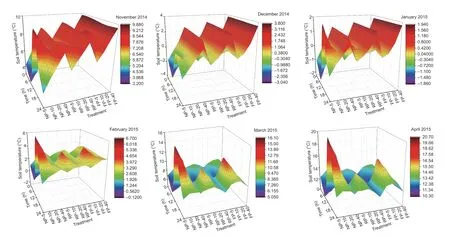
Fig.2 Changes in soil temperature within a 24-h period among different treatments from November 2014 to June 2016.FP, flat soil surface with plastic film mulching; RP, ridge furrow with plastic film mulching; NP, flat sowing without film mulching control.The numbers after labels, i.e., 5, 10, 20 and 40, represent the soil depths.The data are the monthly averages.
The flat soil surface with FP had a warming effect when the soil temperature was low.For instance, the lowest topsoil temperature in the FP treatment was 1.4–2.5°C higher in the overwintering stage in 2014–2015 than in the flat sowing with NP treatment.A cooling effect was also found in the FP treatment when the soil temperature was high in late spring and summer.For example, the highest topsoil temperature in the FP treatment was 3.0–4.2°C lower from March to June 2015 than in the NP treatment.In the ridge furrow with plastic film mulching (RP) treatment, the warming and cooling effects were unstable and varied with year.
Dynamic change in soil temperature during the whole growth stageThe variation in the daily average soil temperatures throughout the wheat life cycle are shown in Fig.3.In general, the soil temperature initially decreased and then increased in the wheat growth period.In the two wheat seasons, the lowest soil temperatures occurred during January 1 and 2, 2015, and January 25 and 26, 2016.The lowest soil temperature in 2015–2016was 1.2–1.5°C lower than in 2014–2015.The daily average soil temperature was enhanced in the FP and RP treatments during the overwintering stage, especially in the FP treatment, which increased by 0.26–0.33 and 0.53–0.77°C, respectively, compared with that in the RP and NP treatments.
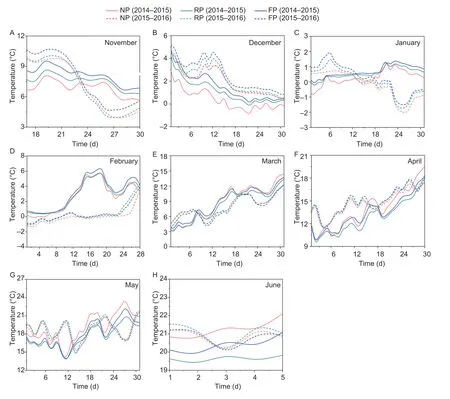
Fig.3 Changes in daily average soil temperature among different treatments during the wheat growth period.NP, flat sowing without film mulching control; RP, ridge furrow with plastic film mulching; FP, flat soil surface with plastic film mulching.Data are the average value of different soil layers.
Accumulated soil temperatureThe active accumulated soil temperatures during the wheat growth periods of 2014–2015 and 2015–2016 were 1 161–1 289 and 1 191–1 251°C d, respectively (Fig.4-A).Compared with the NP treatment, although the active accumulated soil temperature fluctuated in the RP and FP treatments, the amplitudes were weak and irregular (within ±10%).Overall, the negative accumulated soil temperature in 2015 was 66–99% lower than in 2016 (Fig.4-B).The negative accumulated soil temperature in the RP treatment was lower (by 6.6–7.5°C d) than in the NP treatment.The negative accumulated soil temperature in the FP treatment was 0.33–3.31°C d lower than that in the RP treatment.
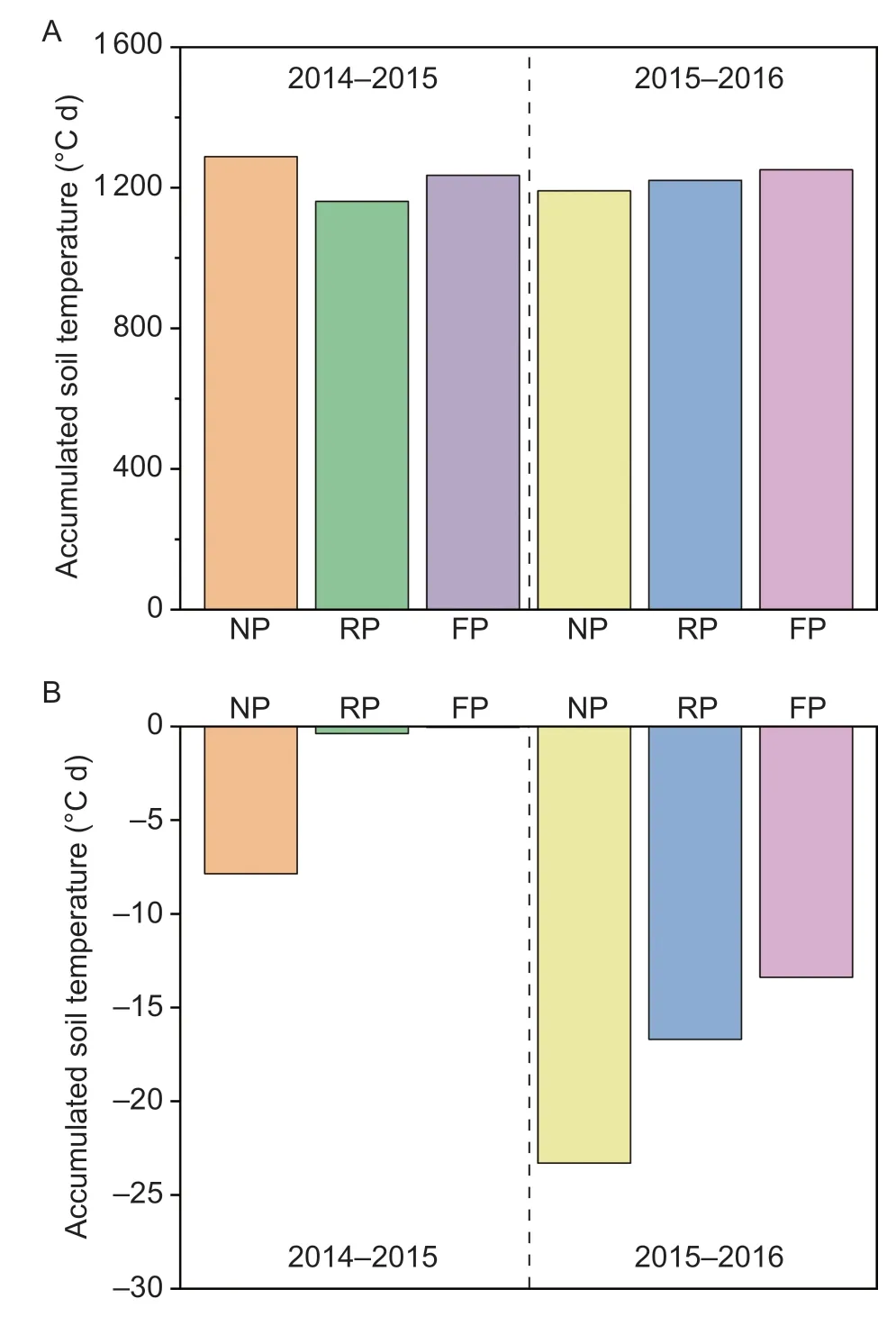
Fig.4 Active accumulated soil temperature (A) and the negative accumulated soil temperature (B).FP, flat soil surface with plastic film mulching; RP, ridge furrow with plastic film mulching; NP, flat sowing without film mulching control.
3.2.Soil moisture
PrecipitationThe annual precipitation at the experimental site from 2006 to 2016 ranged between 328 and 699 mm (Appendix A).The annual rainfall peak occurred mainly in the summer fallow period of winter wheat (from July to September), and accounted for 62% of the annual rainfall.Annual precipitation reached its minimum in December and January and then gradually rose over time.The lowest precipitation was observed, in 2009–2010 and the second lowest in 2015–2016, when it was 20% lower than in 2014–2015.In 2015–2016, the precipitation in the summer fallow period was 65% lower than in 2014–2015.During the wheat growth period, however, the precipitation in 2015–2016 was 108% of that in 2014–2015.
Soil water storageFrom mid-late February or early March, the winter wheat gradually turned green and then grew rapidly in the later growth period when the supply of soil water became more critical.There was little difference in the average water storage (0–40 cm) from the returning green stage to the maturity stage in the two years, which was 46 mm (2014–2015) and 44 mm (2015–2016), respectively.Soil water storage decreased significantly with time from the returning green stage to the maturity stage (Fig.5).During the returning green and the jointing stages of 2014–2015, soil water storage in the three treatments increased in the order FP>RP>FP.In the jointing stage, soil water storage in the FP treatment was by 43–48% greater (P<0.05) than in the NP treatment.A similar tendency was found from the returning green to flowering stages of 2015–2016.However, there were no significant differences in soil water storage among the NP, RP and FP treatments at the maturity stage.
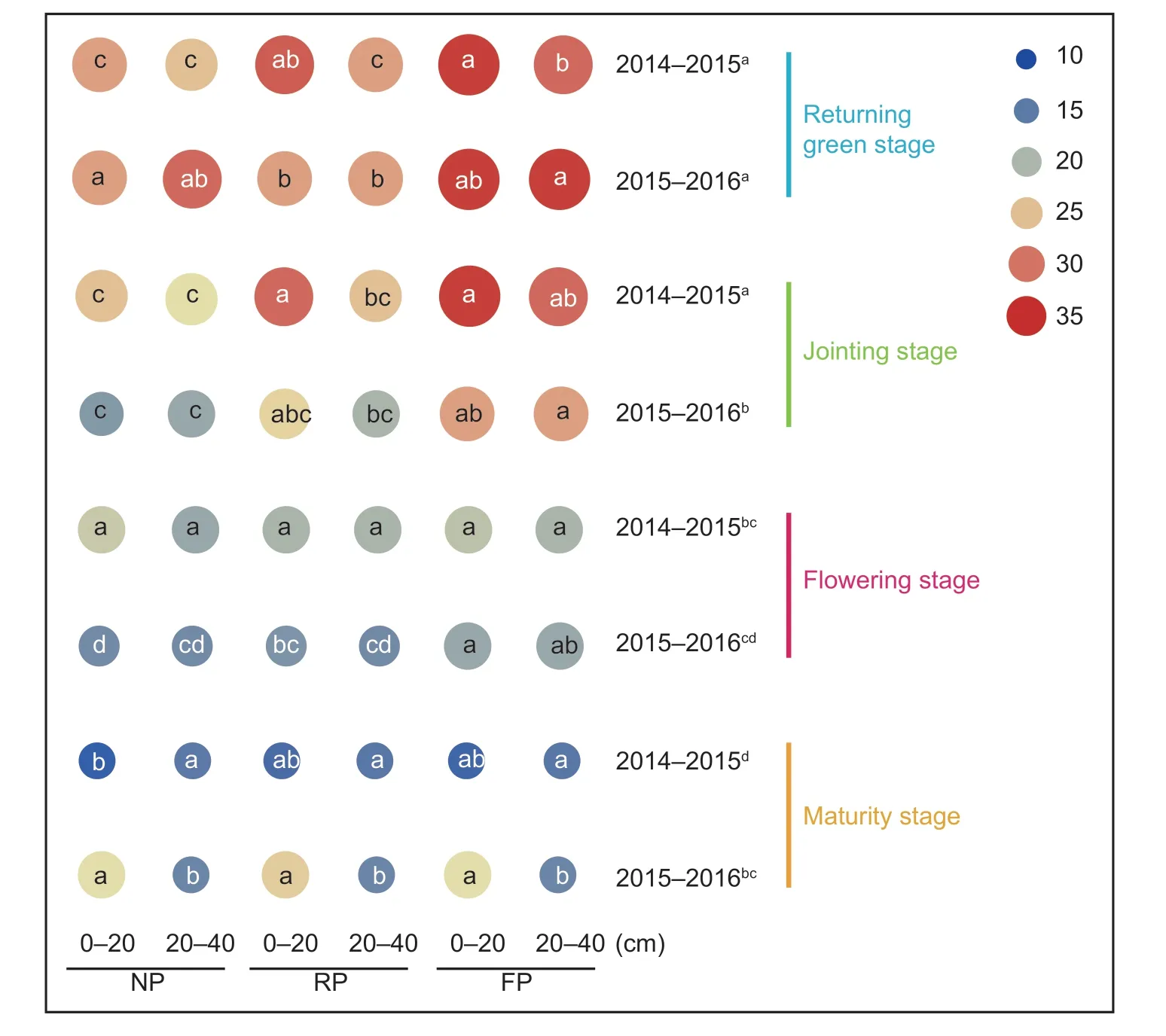
Fig.5 Bubble chart of soil water storage (0–40 cm) at different wheat growth stages.FP, flat soil surface with plastic film mulching; RP, ridge furrow with plastic film mulching; NP, flat sowing without film mulching control.The bubble size is directly proportional to the water storage, and different lowercase letters on the bubble represent significant differences at the same stage of the same wheat growing season.Different lowercase letters in the upper right corner of the year, such as 2014–2015a in the figure, indicate significant differences in soil water storage at different periods.
3.3.Winter wheat yield
Grain yields in the RP and FP treatments were 10–35 and 23–56% higher (P<0.05), respectively, than in the NP treatment (Fig.6-A), while grain yield in the FP treatment was 12–16% higher (P<0.05) than that in the RP treatment.In 2014–2015, spike number in the three treatments declined in the order FP>RP>NP.Spike numbers in the FP and RP treatments were 21 and 17% higher (P<0.05) than those in the NP treatment, respectively (Fig.6-B).In 2015–2016, the spike number of winter wheat in the RP and FP treatments was also greater, by 28–32% (P<0.05) than in the NP treatment.Kernel number differed little among treatments in 2014–2015, whereas in 2015–2016 kernel number in the FP and RP treatments was 18–27% lower (P<0.05) than in the NP treatment (Fig.6-C).Thousand kernel weight was the highest in the FP treatment, which was 5–7% higher (P<0.05) than in the NP treatment (Fig.6-D).
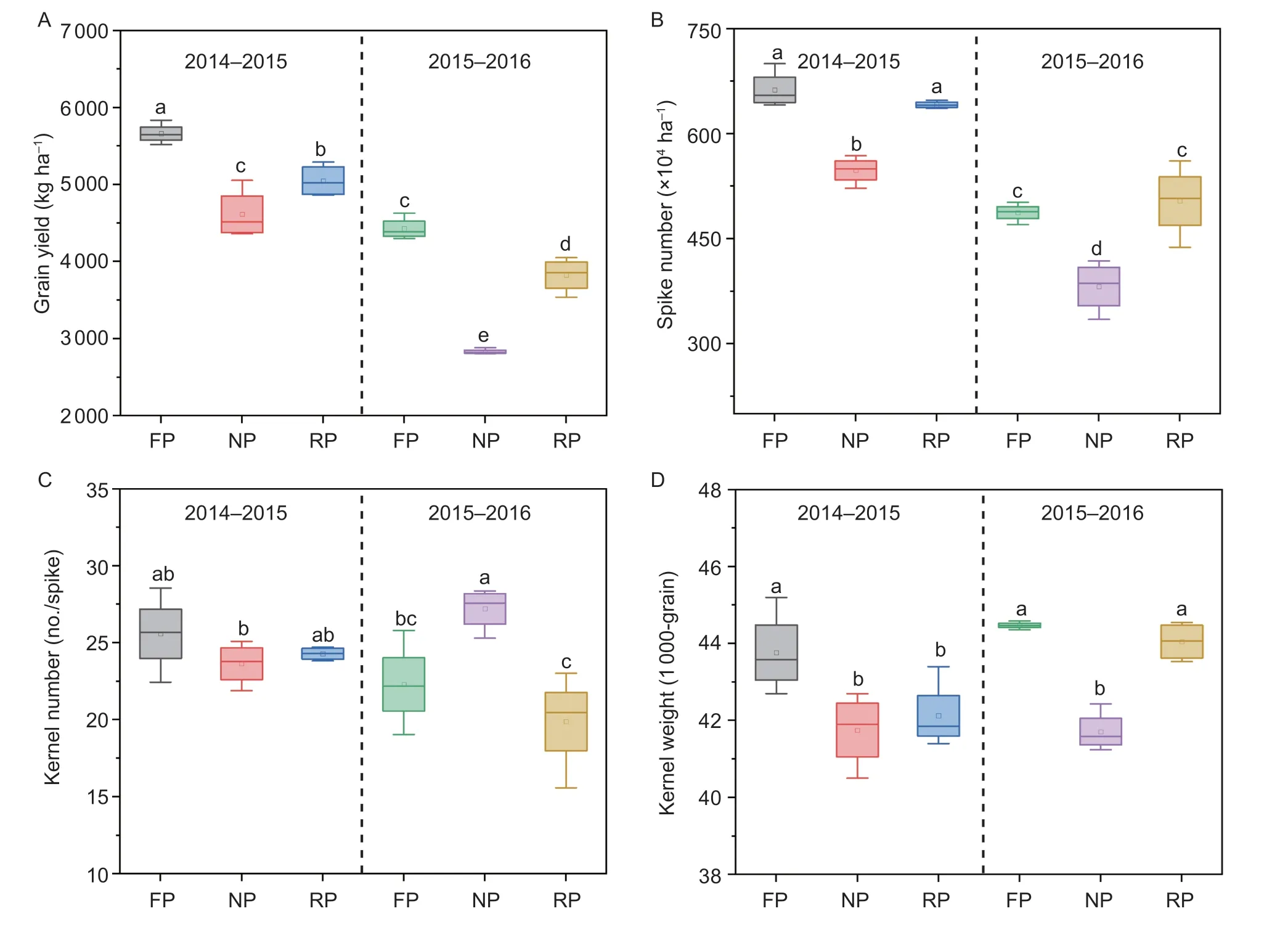
Fig.6 Grain yield (A), spike number (B), kernel number per spike (C) and thousand kernel weight (D) of winter wheat.FP, flat soil surface with plastic film mulching; RP, ridge furrow with plastic film mulching; NP, flat sowing without film mulching control.Error bars are SD (n=4).Different lowercase letters represent significant differences at the 0.05 level between different treatments.
3.4.Soil bacterial community
By sequencing the bacterial community in soil samples, a total of 33 135 effective sequences with average lengths of 418 bp were obtained (Appendix B).The rarefaction curves showed an initially increasing and then gradually flattening trend (Appendix C), indicating that sequencing had become saturated, and more OTUs could hardly be found with the increase in sequencing data.Meanwhile, the coverage estimators of all treatments were higher than 97%, which again suggested that the sequencing depths could well reflect the bacterial community in the soil.
Bacterial community diversityChao1 and Shannon indices in the RP treatment were significantly higher, by 17 and 3.9% respectively, than in the NP treatment (P<0.05; Appendix B).At the OTU level, principal coordinate analysis (PCoA) of the bacterial communities carried out using the Bray Curtis revealed that axis 1 explained 42.55% of the variance, and axis 2 explained 26.07% (Fig.7-A).The clustering results showed that the bacterial communities of different treatments clustered together, and the difference reached significant levels (P<0.05), indicating that the structure of the soil bacterial community was significantly changed in the RP treatment.
Bacterial community at the genus levelTo explore the effect of mulching method on bacterial community structure during the overwintering period, the 35 most abundant genera were selected for study (Fig.7-B).The top five genera were unclassified_k__norank_d__Bacteria (18.7–18.8%),Gaiella(3.6–7.4%),Vicinamibacter(3.3–3.7%), unclassified_f__Vicinamibacteraceae (3.0–3.3%) andSolirubrobacter(2.5–3.4%).Relative abundances ofGaiella,VicinamibacterandSolirubrobacterwere lower in the RP treatment, by 51, 11 and 27%, respectively, than in the NP treatment, whereas that of unclassified_f__Vicinamibacteraceae was 11% higher.In addition, the relative abundance ofSphingomonas,Microvirga, unclassified_f__Geminicoccaceae andPaludibaculumin the RP were significantly higher, by 52, 69, 56 and 82% (P<0.05; Student’st-test) respectively, than in the NP treatment.Notably, the abundance of unclassified_o__Rhizobiales in the RP treatment was 33% higher than in the NP treatment, however this difference was not significant.

Fig.7 Principal coordinate analysis (PCoA) of the bacterial community (A) and the change in the bacterial community (top 35) at the genus level after plastic film mulching (B).* represents the significant difference in species between flat sowing without film mulching control (NP) and ridge furrow with plastic film mulching (RP).
lnterspecific relationships of the bacterial communityNetwork analysis was performed to reveal the effects of the mulching treatments on the interspecific relationships of microorganisms at the genus level.Although the number of nodes in the two treatments was similar, the microbial links (number of edges) in the RP treatment was 38% lower than in the NP treatment (Appendix D).Furthermore, the network topology parameters, including the average number of neighbours, the clustering coefficient and the network density, were analysed to evaluate the stability of the network.The value of the clustering coefficient in the RP treatment was 18% greater than in the NP treatment, whereas the average number of neighbours and network density were lower in the RP treatment, by 32 and 26%, respectively.According to the MCODE application, although each network had two submodules, the average score of submodules in the RP treatment was 27% lower than in the NP treatment.
4.Discussion
Previous studies have suggested that wheat yield was determined by kernel number per spike and kernel weight (Tianet al.2011; Lo Valvoet al.2018; Dinget al.2020).In the present study, a significant positive correlation was observed between grain yield and spike number (per hectare) (r=0.943,P<0.01; Appendix E), indicating that spike number (per hectare) was an important factor for wheat yield in the experimental area.This result suggests that in some extreme environments, such as droughty or cold environments or environments with depleted soils, spike number (per hectare) might become more critical for grain yield.The emergence, tillering and turning green of winter wheat might be hindered by temperature, moisture and soil fertility stress in extreme environments, which may ultimately reduce the spike number of winter wheat.In this study, the grain yield and spike number in 2015–2016 were 22–39 and 21–30% lower than in 2014–2015, respectively (Fig.6).A likely reason for this is that the annual precipitation in 2015–2016 was 20% lower than in 2014–2015 (Appendix A).Another reason may be that the continuous low temperatures in January and February 2016 might have restricted the wheat from turning green (Fig.2), which is supported by the 23–52% reduction in the tiller number at the returning green stage in 2015–2016 compared with that of 2014–2015 (data not shown).
The average annual precipitation of the experimental site was low (average 454 mm; Appendix A), especially for the growth period of winter wheat, during which rainfall accounted for only 38% of the average annual rainfall.Although the precipitation from the returning green to maturity stages in 2015–2016 was 50% higher than in 2014–2015 (Appendix A), the average water storage (0–40 cm) during the above periods showed little difference (Fig.5).This is attributed to the more sufficient water storage before wheat sowing in 2014–2015 than in 2015–2016 (Appendix F).The water stored in the deep soil during the summer fallow period was probably transferred to the topsoil for wheat absorption.Liet al.(2018) also showed that the yield and spike numbers of winter wheat in 2012–2013 were significantly lower than in 2011–2012 because the precipitation in the summer fallow period of 2012–2013 was 63% lower than in 2011–2012.
Although the rainfall in the summer fallow period of 2014–2015 was nearly three times that of 2015–2016 (Appendix A), the water storage of the 0–200 cm soil layer before wheat sowing in 2014–2015 was only 24–45% higher than in 2015–2016 (Appendix F).This meant that the precipitation in the summer fallow period of winter wheat was ineffectively stored.Therefore, effectively increasing the soil water storage in the summer fallow period is crucial.In addition to the application of water retaining agents (Liuet al.2020; Kassemet al.2021) and organic fertilizer (Zhouet al.2020), the use of film mulching in the summer fallow period could also contribute to the retention of soil moisture (Liet al.2019).
In our previous research, the consumption of water in the 40–100 cm soil layer in the FP and RP treatments was 46 and 14% greater than in the NP treatment, respectively (Zhaoet al.2018).It is possible that deep soil water might be transferred to topsoil for crop growth in the RP and FP treatments.In the present study, the soil moisture content in the RP and FP treatments was higher than in the NP treatment at the returning green and jointing stages, which was conducive to an increase in wheat yield.However, soil water resources are limited in the arid and semiarid areas of the Loess Plateau of China, making it difficult to supplement the water consumed in the deep soil at the later stage of wheat growth.During the wheat harvest, the water storage of the 100–200 cm soil layer in the RP and FP treatments was respectively 19.8 and 20.4% lower than that in the NP control (Zhaoet al.2018).Therefore, in the later growth period of winter wheat in arid areas, the deep soil water storage is likely to be overdrawn, which makes it more difficult for water to be transferred from the deep soil for wheat use where plastic film mulch is used.On the one hand, soil water storage decreased with time; on the other hand, there was little difference in topsoil water storage in different mulch treatments at the later stage of wheat growth (Fig.5).
Our results indicated that RP and FP treatments could increase soil temperature when the temperature was low and reduce the temperature when it was high, which was consistent with the results of previous studies (Yanget al.2018; Denget al.2019; Li Y Wet al.2021).The regulating ability of soil temperature was more stable in the FP treatment than in the RP treatment.The correlation analysis revealed that there were significant positive correlations among the negative accumulated soil temperature, spike number and wheat yield (r=0.943–1.0,P<0.01; Appendix E).This result suggests that low-temperature stress might delay wheat regreening and reduce the spike number and wheat yield.Low temperature in spring was found to decrease tiller number in winter wheat, gas exchange rates and maximum quantum efficiency of photosystem II in wheat leaves, which decreased spike number and wheat yield by 8–15 and 5–14%, respectively (Liet al.2015).The damage of low-temperature stress to wheat might cause the mortality of tillers and plants, increase respiratory loss and shorten grain filling duration (Taoet al.2017; Zhenget al.2018).Furthermore, the correlation analysis in our study showed that wheat yield was not significantly correlated with the active accumulated soil temperature (Appendix E).The results of a survey have shown that during the past 30 years in the Huang-Huai-Hai Plain of China, with the increase in the minimum temperature in the wheat growth period, the average wheat yield increased by 15%; in contrast, the maximum temperature had a smaller impact on yield (Taoet al.2017).
In the RP treatment, not only did the Shannon and Chao1 indices show significantly higher values than those in the NP treatment (P<0.05; Appendix B), but also the bacterial community structure changed significantly (P<0.05; Fig.7-A).This result indicated that the microbial activity was probably improved in the RP treatment, which may be attributed to the warming and moisturepreserving effect of that treatment.The abundances ofSphingomonas,MicrovirgaandPaludibaculumin the RP treatment were significantly higher than in the NP treatment (Fig.7-B).The genusSphingomonashas been reported as being a phosphorus-solubilizing bacteria that could efficiently release soluble phosphate from rock phosphate (Li Yal.2021).Microvirgasp., isolated from nitrogen-fixing nodules ofLupinusmicranthusandL.luteus, was identified as a heterotrophic nitrogenfixing bacterium (Msaddaket al.2019; Lanet al.2021).Thus, the RP treatment could enhance the activity of microorganisms that promote nutrient transformation and enhance nutrient availability for wheat growth.In addition, the genusPaludibaculumsp.is a denitrifying bacterium that could reduce nitrate to nitrite (Heet al.2021; Yuet al.2021), thus the RP treatment may have affected N availability and uptake.
The nitrogen cycle can include six processes, however nitrogen-transforming microorganisms are rarely accurately categorised into the processes they influence due to their metabolic versatilities (Kuyperset al.2018).Hence, process names, such as nitrification and nitrogen fixation, were employed to avoid the corresponding classification of microorganisms in this study.Twelve nitrogen cycle processes were found, which represented twelve nitrogen cycling microbial groups (Fig.8-A).Nitrate nitrogen and ammonium nitrogen are important inorganic nitrogen sources during winter wheat growth, particularly nitrate nitrogen, which is preferred by wheat (Wanget al.2016).Thus, the processes from nitrogen fixation and ammonification to nitrification can provide more available nitrogen sources for wheat.In the present study, microbial groups with the functions of ureolysis, nitrogen fixation, nitrification, aerobic ammonia oxidation and nitrite oxidation were found (Fig.8-B), and the abundance of these microbial groups in the RP treatment was higher than in the NP treatment (except for nitrogen fixation).The microbial groups associated with ureolysis and nitrification were significantly more abundant, by 25 and 16% (P<0.05), respectively, in the RP treatment than in the NP control (Fig.8-A).
Nitrate reduction processes may reduce the supply of nitrate for wheat.In the present research, nitrate reduction processes mainly included nitrate respiration, nitrite respiration, denitrification, nitrate denitrification, nitrite denitrification and nitrous oxide denitrification (Fig.8-B).Remarkably, the abundances of microbial groups with the above functions were lower in the RP treatment than in the NP control, and the differences were significant except for nitrate respiration (Fig.8-A).Interestingly, the abundance of plant pathogenic bacteria in the RP treatment was significantly lower, by 48% (P<0.01), than in the NP treatment (Fig.8-A).
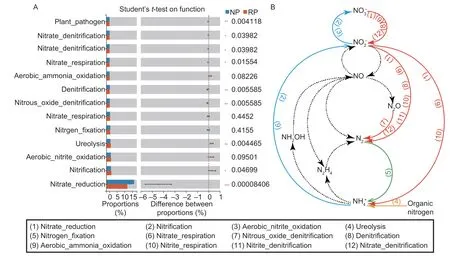
Fig.8 Change in nitrogen cycling microbial groups after plastic film mulching by the FAPROTAX database (A) and proposed nitrogen cycle path (B).RP, ridge furrow with plastic film mulching; NP, flat sowing without film mulching control.The solid lines represent the nitrogen cycle pathway found in this study, and the dotted lines represent the undiscovered potential nitrogen cycle pathway.
The network topology parameters reflected the affinities of interspecific relationships.In the current research, the topology parameters (except the clustering coefficient) and submodule scores in the RP treatment showed a decreasing trend compared with the NP treatment, which indicated that the complexity and stability of microbial interactions may be weakened in the RP treatment (Appendix D), which is consistent with previous studies (Liu J Let al.2021; Luoet al.2022).The reasons for this weakening may be firstly that the RP treatment provided a comfortable soil environment for microbial growth (Liu J Let al.2021), and interspecific relationships, including cooperation and competition, might be weakened by favourable environments (Maet al.2018), and secondly that the plastic film may have been toxic.In this study, however, the microbial activity was strengthened in the RP treatment.Therefore, the former reason may be the main point for reducing microbial interactions.
5.Conclusion
At an experimental site in the Loess Plateau of China, low temperature stress decreased the spike number per hectare of winter wheat, thereby reducing wheat yield, while high temperature had little effect on yield.Compared with ridge furrows with plastic film mulching, a flat soil surface with plastic film mulching had a greater ability to regulate soil temperature and deep soil moisture content and provided a more suitable environment for wheat growth, which was beneficial for wheat yield.Although interspecific bacterial relationships were weakened in the ridge furrows with plastic film mulching, bacterial activity was improved, and the bacterial community structure was changed.Ridge furrows with plastic film mulching enhanced the abundances of phosphorus-solubilizing, ammonifying and nitrifying bacteria but also reduced abundances of microbes with nitrate reducing ability and plant pathogen activity, which increased wheat yield.
Acknowledgements
This work was supported by the State Key Laboratory of Integrative Sustainable Dryland Agriculture (in preparation), Shanxi Agricultural University, China (202105D121008), the National Natural Science Foundation of China (42007121), and the National Key R&D Program of China (2021YFD1900700).
Declaration of competing interest
The authors declare that they have no conflict of interest.
Appendicesassociated with this paper are available on https://doi.org/10.1016/j.jia.2023.02.026
杂志排行
Journal of Integrative Agriculture的其它文章
- Herbicidal activity and biochemical characteristics of the botanical drupacine against Amaranthus retroflexus L.
- Developing a duplex ARMS-qPCR method to differentiate genotype l and ll African swine fever viruses based on their B646L genes
- The effects of maltodextrin/starch in soy protein isolate–wheat gluten on the thermal stability of high-moisture extrudates
- Elucidation of the structure, antioxidant, and interfacial properties of flaxseed proteins tailored by microwave treatment
- lnversion tillage with straw incorporation affects the patterns of soil microbial co-occurrence and multi-nutrient cycling in a Hapli-Udic Cambisol
- The effects of co-utilizing green manure and rice straw on soil aggregates and soil carbon stability in a paddy soil in southern China
